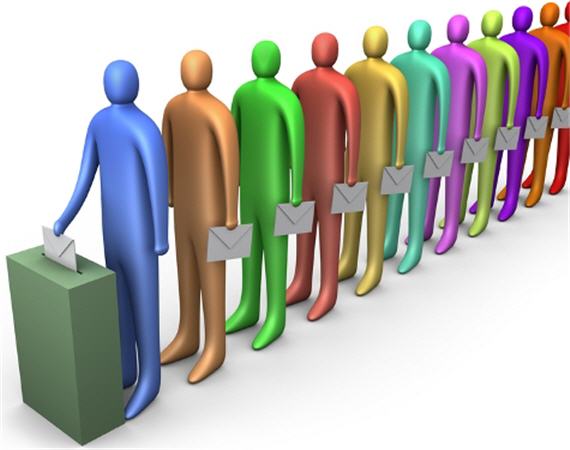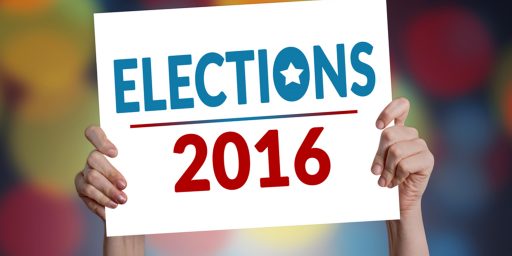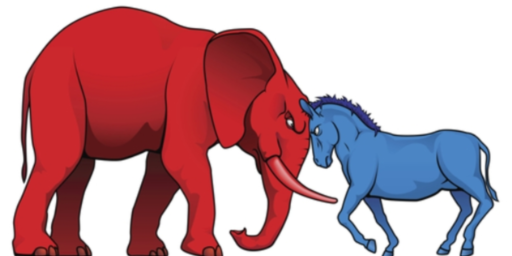Republicans and Likely Voter Polls
Nate Silver provides yet more bad news for Democrats: When screening for "likely voters," Republican numbers look even better.
Nate Silver provides yet more bad news for Democrats: When screening for “likely voters,” Republican numbers look even better.
We now notate whether each poll is of likely voters, registered voters, or all adults, and include variables for this in the regression analysis we use to calculate pollster house effects. The regression shows that, holding house effects constant, Democrats do a net of 4 points better in polls of registered voters (with a 95 percent confidence interval of about 2-6 points) than in polls of likely voters, and roughly 7 points better in polls of all adults. So if we took, for example, the recent Ipsos poll of California, a poll of registered voters which showed Barbara Boxer with a 4-point lead over her Republican challenger, Carly Fiornia, we would expect it to show about a tied race if a likely voter screen had been applied instead.
The adjustment works in exactly this fashion: it adds a net of 4 points to the Republican candidate’s margin each time that it encounters a poll of registered voters, and 7 points every time that it encounters a poll of adults (which is very rare in state-level polling.) Polls of likely voters are left unchanged as having a likely voter screen is assumed to be the default condition.
In 2008, I had been reluctant to be overly aggressive about using likely voter polls this far out from the election. In fact, when the pollster had presented us with a choice of a registered voter and a likely voter poll, we went with the registered voter numbers until Labor Day. The reason for my change of heart is twofold. First, by the time we get to November, essentially all polls will be of likely voters. In other words, we are essentially predicting what the polls are likely to show in due time anyway, once all pollsters have switched to a likely voter model. This should lend additional stability to the forecasts, as they will converge toward their final estimates more quickly. Secondly, there is substantial quantitative and qualitative evidence of an enthusiasm gap between Democratic and Republican voters, which we would quite naturally expect to be reflected in likely voter polls but not so in polls of registered voters. (It is probably also the case that registered voter polls generally somewhat underestimate Republicans’ performance in midterm elections even when the mood of the country is fairly neutral, but that is especially likely to be the case in a year like this one, where enthusiasm is imbalanced).
Likely voter screening is as much art as it is science, with some pollsters better at it than others. But it has been true for as long as I can remember that Republicans outperform “registered voter” polls. With rare and brief exceptions, Democrats have had a modest advantage in mass preference that disappeared or even turned in to a modest deficit on election day. Mostly, this is because young adults and African Americans are less likely to vote than other cohorts.
Based on his current numbers, Silver gives Republicans a 12 percent chance of taking over the Senate — 17 percent if Charlie Christ caucuses with them. And “the model does not account for the contingency that someone like Joe Lieberman or Ben Nelson could decide to switch parties.” Such realignments of conscience seem to happen when there’s a tide of voter sentiment. It’s worth noting, too, that he gives Democrats a 7 percent chance of gaining a seat and re-establishing their 60 vote supermajority.
The other thing that stands at in the post is how few of the seats are even remotely competitive. Even in what’s supposed to be a wave of anti-incumbent fever and voter rage, the vast majority of seats have one candidate up by a wide margin.







Big grain of salt.
55% of the polls used in this model come from Rasmussen. As Nate has documented, they have a significant GOP bias even after accounting for their “likely voter” screen.
“Likely voter screening is as much art as it is science”
Especially when there is not an election in the very near future. If you can’t ask voters whether they intend to vote in the election coming up in a few weeks, then how do you determine whether they are “likely voters”? Rasmussen always uses this “likely voter” screen, and what they do is to take actual polling data, wave their own proprietary model of who they think is likely to vote over the data, and get a result. In other words, they fudge the data in a non-transparant manner – they release whatever result they want to release. How can anyone be sure they do not tweak their model on a daily basis so as to reach their desired result?
They are a propaganda firm, not a polling firm.
@tano
Rasmussen always uses this “likely voter” screen, and what they do is to take actual polling data, wave their own proprietary model of who they think is likely to vote over the data, and get a result.
I’m no apologist for Rasmussen, whose numbers I suspect and which is a competitor of my wife’s firm. But waving one’s model of who they think likely to vote over the data is how all companies do likely voter screening. It’s heavily weighted toward people who have actually voted in the past, with some additional factors based on intensity. It’s a judgment call — again, more art than science — but both necessary and generally accurate.
It almost always emerges that, despite hype of huge turnout by blacks and young voters, that the actual behavior closely mirrors past behavior.
‘But waving one’s model of who they think likely to vote over the data is how all companies do likely voter screening. ”
Really? I was under the impression that the usual way to screen for likely voters is to ask people whether they intend to vote – or how likely it is that they will vote. Or some other specific question that gives you a reasonable sense of the likelihood that they will vote.
Which is why it is not really practical to do such likely voter screens if there is no election imminent.
To expand on my last comment. This is a very different ‘screen” than what Rasmussen does. He uses categories of people – X% of blacks will vote, therefore I can eliminate all black respondents over that number. But of course he does not tell anyone what X is equal to, so he can pretty much make things up as he wishes.
The proper way is to screen specific respondants based on their expressed interest in voting, rather than categorizing them, and weighting the categories.
Am I wrong about all this?
@tano
If Rasmussen does what you describe, then he’s a hack. As to this:
It’s more complicated than that. Just as in stocks, past performance isn’t necessarily a prediction of future results — but it’s the best one we’ve got!
Likely voter screens should way expressed intentions to vote along with past behavior. How, exactly, that’s done, I don’t know. I’ve heard professional pollsters talk about it but I’m not a professional (or, indeed, even an amateur) pollster.